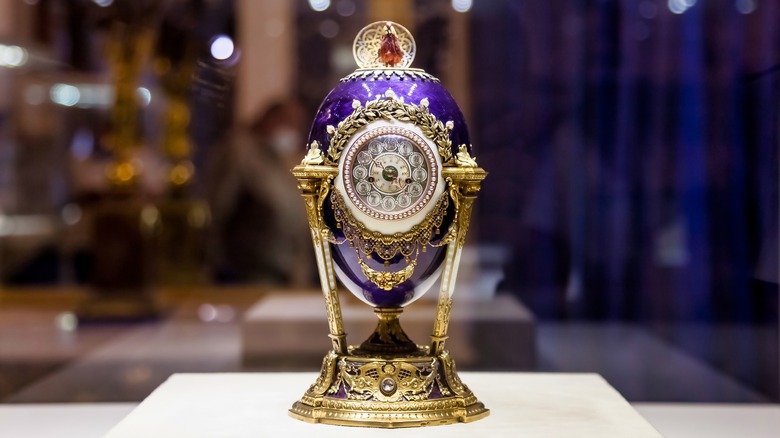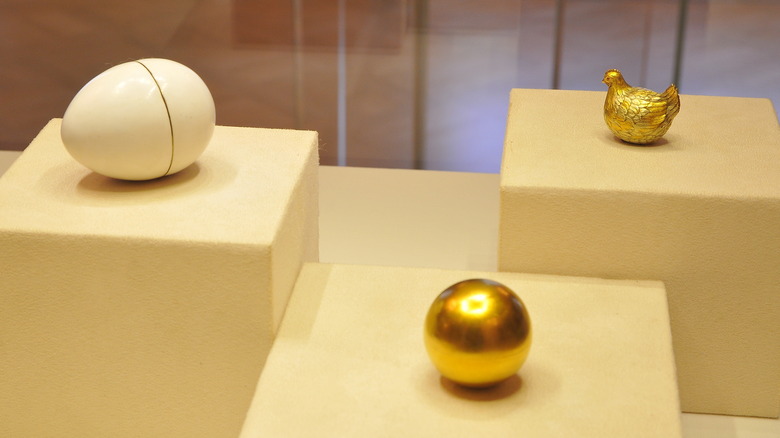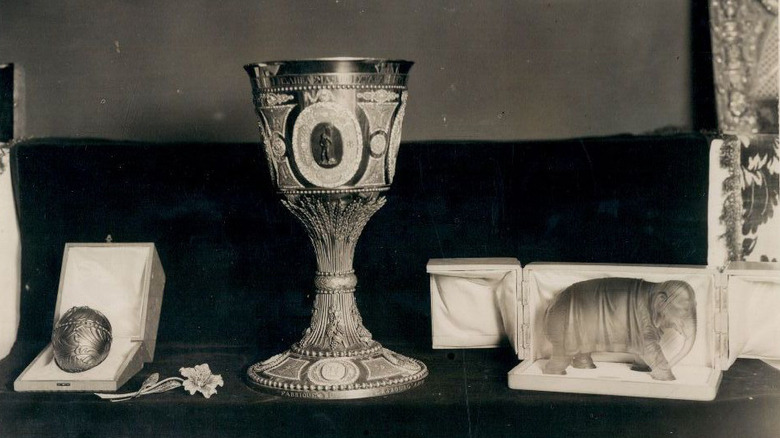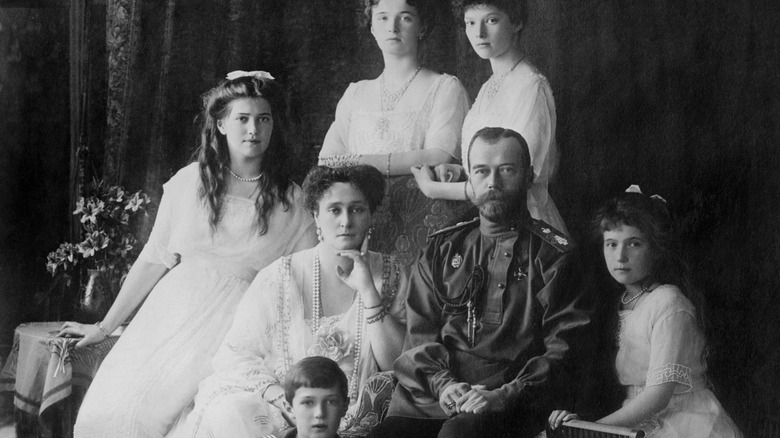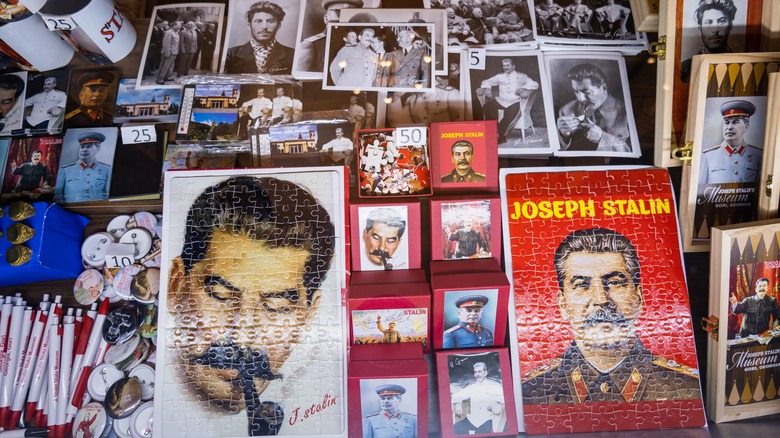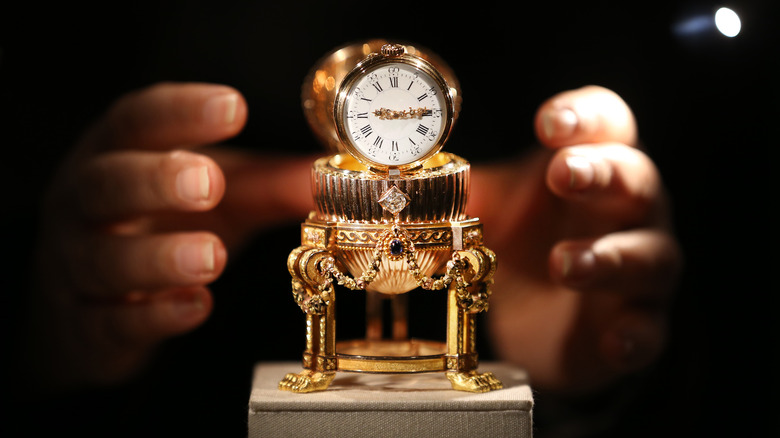The Missing Fabergé Eggs Of The Romanov Family
Fabergé eggs are definitely some of the more unusual and iconic decorative items from history. Highly ornamented, finely crafted, jewel-studded egg-shaped objects displayed on pedestals of gold or other precious materials? They're true objet d'arts: items serving no functional purpose but to beautify an environment simply by existing. You put them on a shelf, table, etc., admire their craftsmanship, comment on this or that facet, and that's that. In other words, they're the perfect gift between royalty. And for the Russian Romanov royal family, they were something of a tradition.
The recognizable name "Fabergé" was the surname of the person who started making them, Peter Carl Fabergé. In fact, Fabergé never went out of business — it passed hands and still exists to this day making high-end jewelry and commemorative items. Back in 1882 when Peter took over the family jewelry business, he had a unique vision for how it would operate. He wanted to focus on colorful, detailed designs that incorporated elegant goldsmithing into the mix and focused on more than just diamonds. And so Peter's work caught the eye of the Romanovs.
In 1885, three years after Peter set to work overhauling his family business, Tsar Alexander III of the House of Romanov commissioned from Fabergé a special birthday present for his wife, Empress Maria Feodorovna. Thus began a long, 30-year history of royal Fabergé egg gifts. Fabergé created 69 eggs, including 52 for the Romanovs. Only 46 of those remain.
A gift fit for royalty
Admittedly, the very first Fabergé egg — the one that Tsar Alexander III gave to Empress Maria Feodorovna — comes across as much more minimalist than the ones that came after it. Nonetheless, it still puts Peter Carl Fabergé's creativity and craftsmanship on full display. The egg — dubbed the "Hen Egg" — is constructed like a child's toy: a white enamel egg with a golden ball inside and a little golden hen inside that. Luxury Columnist says it's worth about $6 million. But more importantly, the Hen Egg set Fabergé on a course to outdo itself with every subsequent commission.
Empress Feodorovna was over the moon about her gift, and when Tsar Nicholas II came to power he commissioned one Fabergé egg annually for his wife and mother. The eggs came to be synonymous with Romanov power, although few outside of royal circles knew that they even existed. Following in the tsar's footsteps, other aristocratic families like the Yusupovs started commissioning eggs. The Yusupovs were obscenely wealthy — moreso than the tsar and the Romanovs. And so when Prince Felix Yusupov I tapped Fabergé to make an egg, the result was truly over-the-top. The Yusupov Clock Egg, as it came to be called, is a gold-gilded, diamond-encrusted, rouge-hued egg on a pedestal with an actual, little clock inside the egg. It's even got a little golden key to open the egg.
[Featured image by Михаил Овчинников via Wikimedia Commons | Cropped and scaled | CC BY-SA 4.0]
The six lost eggs
In case you couldn't glean, each Fabergé egg had a unique, individual theme reflected in its design. Each was also custom-made for a certain person, national event, or fragment of shared culture. A quick look at the full egg list on PBS reveals names as inventive as the designs themselves: Colonnade Egg, Lilies of the Valley Egg, Rosebud Egg, Blue Serpent Clock Egg, Cradle with Garlands Egg, Empire Nephrite Egg, and so on. Innovato Design has a spectacular, immensely thorough breakdown of every single egg ever made, including pictures for eggs whose whereabouts we know and illustrations for lost eggs without pictures.
Fabergé produced their objet d'art eggs for Russian aristocrats all the way from the first Hen Egg produced in 1885 to the Order of St. George Egg and Steel Military Egg produced in 1916. The name and timing of those last two eggs tell us everything we need to know about the fate of Fabergé's eggs — they were produced the year before the Russian Revolution overthrew the nation's 300-year-long tsarist regime.
There's an unusual amount of disparity amongst sources, with exact numbers of lost eggs varying, but we can confirm that six Romanov eggs are missing — 46 out of 52 total made for the Romanov family, per Trinket Gems. The lost eggs are: Hen with Sapphire Pendant (1886), Cherub with Chariot (1886), Nécessaire (1889), Mauve (1897), Royal Danish (1903), and Alexander III Commemorative Egg (1909).
The death of the Romanov dynasty
The end of Fabergé egg production for the Romanovs ended with the deaths of the Romanovs themselves. Trouble in Russia — a massive, multiethnic state historically plagued by class contention and geographic isolation — took off in a modern sense in 1861. Back then, Tsar Alexander II — the father of Alexander III, who commissioned the first Fabergé egg in 1885 — overhauled Russia's very medieval system of social serfdom. Russia was behind the times technologically and societally and had to struggle to try and catch up, as ThoughtCo. explains.
Released Russian serfs, however, got locked into a usurious system of payments for land they'd already worked before being freed and which they technically didn't own, anyway. Meanwhile, the Russian government pushing hard for rapid industrialization. Farmers fled to cities to escape rural poverty only to find themselves in situations of equal — but different — urban squalor. Under such repressive conditions it's no surprise that a Marxist-influenced worker's rights ideology arose within Russian society: communism.
Come 1905, tensions hit a peak. In what became known as "Bloody Sunday," Tsar Nicholas II — a pious but notoriously "weak-willed" man, per History — sent troops to kill hundreds of protesting workers in St. Petersburg. In the midst of governmental upheaval during World War II, Vladimir Lenin rose to power during Russia's 1917 Bolshevik Revolution. In 1918 the entire Romanov family was executed, thus ending 300 years of Romanov rule and their commissions of Fabergé eggs.
The fate of Fabergé
As the reader can imagine, political upheaval has a way of making items vanish and get destroyed. This is especially true if those items are ostentatious displays of wealth in the middle of a worker's revolt. The Fabergé eggs got lost during the Bolshevik Revolution and subsequent transfer of power to a new, state-controlled, communist government. Peter Carl Fabergé fled Russia in 1918 and died two years later in Switzerland. His children tried to revive the family business, but by then Fabergé had become a state-owned Soviet business, House of Fabergé. Eventually, Fabergé became a kind of trademark and passed through various hands until Fabergé Limited bought the rights as recently as 2007.
Many Romanov-commissioned Fabergé eggs made their way into Soviet governmental hands in 1922. A scant five years later in 1927 Joseph Stalin — the dictatorial madman who stepped into the vacuum of power left by the dead revolutionist Vladimir Lenin — sold many of the eggs to buyers outside of Russia for cash. This is how Fabergé eggs wound up in galleries around the world. The biggest extra-Russian collection — nine eggs — wound up in the hands of wealthy entrepreneur Michael Forbes in New York City. Given all these changes of power and the violence that propelled them, it's somewhat miraculous that only six eggs are missing.
The egg hunt continues
At present, the great Fabergé egg hunt continues — at least silently and passively. After all, there's no way to even begin to guess where the missing eggs might be, or if they weren't simply obliterated by a bomb or collapsed ceiling or something over the last 100 years. But there is a bit of hope that a couple more might be found, at least.
As Barneby's recounts, an anonymous tag saler purchased an ornate, golden, egg-shaped item with a clock inside for $13,302 in 2004 (pictured above). No one wanted to buy it from him. Then in 2015 he found a 1922 photo showing a collection of Romanov goods. In the photo was a very tiny, very blurry version of his very egg. Unbelievably, he'd discovered the Third Imperial Egg from 1887. It's the most expensive Fabergé egg on record, worth $33 million.
As mentioned, Fabergé eggs are housed in galleries around the world. Nine of them reside in the Fabergé Museum in St. Petersburg, Russia along with 4,000 other non-egg items crafted by Fabergé. Museums like the Metropolitan Museum of Art, meanwhile, have curated a host of other Fabergé items. On top of all this, the Nécessaire Egg was actually found and bought by London jeweler Wartski. It went on display in 1949 but was bought by "a stranger" — the actual purchaser name on record — in 1952 and has since vanished. As for the rest of eggs: let the hunt resume.
